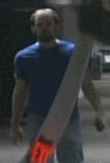|
|
This topic comprises 2 pages: 1 2
|
|
Author
|
Topic: Splicer Repair
|
Randy Stankey
Film God

Posts: 6539
From: Erie, Pennsylvania
Registered: Jun 99
|
 posted 04-04-2001 05:03 PM
posted 04-04-2001 05:03 PM




Lately I have collected up a bunch of Neumade splicers for repair. I have five of them sitting on my living room floor. I have gotten two of them back in good order by cannibalizing parts off the other three and I'm waiting for parts so I can get the others back together.I took them apart and cleaned them all up then reassembled what I could. I know that the "base plate" and the "punch pins" are matched sets that can't be mixed up. I also know that they only go back toghether ONE WAY. After a bit of tinkering I have figured out how to align these parts and get them working right. The last thing that eludes me is how to align the razor blades so they shave off the tape even with the edge of the film without cutting a notch into it. Anybody have any tricks they want to share?
PS: If you "kids" out there who think you know everything want a good reason NOT to tinker with stuff, just come over to my place and take a look at all the parts I have to throw away because some little PIPSQUEAK like YOU decided to tear a splicer apart and couldn't get it back together! -- If I catch you taking something apart like this, I SWEAR I'm going to THROTTLE you! 
| IP: Logged
|
|
|
|
|
|
John Walsh
Film God

Posts: 2490
From: Connecticut, USA, Earth, Milky Way
Registered: Oct 1999
|
 posted 04-04-2001 07:51 PM
posted 04-04-2001 07:51 PM




I've never interchanged parts on those splicers before. But when I put them back together, I leave the bottom plate (with the perf holes) loose, then slide the punch down into the holes. Then tighten the 4 screws on the bottom. The plate only goes on one way.I know this sounds strange, but when you tighten those 4 screws, sometimes it needs to be done in a sequence. I forget now, but either tighten the two outside screws first, then the inside, or visa versa. There are two screws for each side for the thing that holds the side cutting razors. As far as I know, there's no trick for it; you just have to fiddle with (and test on scrap film) until it's right.
| IP: Logged
|
|
|
|
|
|
|
|
John Walsh
Film God

Posts: 2490
From: Connecticut, USA, Earth, Milky Way
Registered: Oct 1999
|
 posted 04-05-2001 08:35 AM
posted 04-05-2001 08:35 AM




Randy; If you have to do it often enough, would it be worthwhile to make a fixture to position the blades for you?Sean; It's true that by tinkering a person can fix and learn alot. But, don't forget that a service tech may have to repair that automation many years from now, long after you have left the company. If there's no schematic diagram showing what was added and how it was done, it could make it harder. I am guilty of adding parts myself (big time!) But, when I did it, our company only had 20 screens or so, and we had the same service guy. Now that we are approching 200 screens and use several different service people across 6 states, anything other than a "out of the box standard install" would seriously add to maintaince costs.
| IP: Logged
|
|
|
|
|
|
|
|
Paul G. Thompson
The Weenie Man

Posts: 4718
From: Mount Vernon WA USA
Registered: Nov 2000
|
 posted 04-07-2001 05:10 AM
posted 04-07-2001 05:10 AM




When it comes to splicers, You get what you pay for. Many people do not realize how precision those splicers are. Yesterday, I made a demonstration of a splice with one of those brand new beaver-tailed $150.00 sledgehammer specials, as compared to a fifteen year old Neumade splicer with dull blades. There was no comparison. The Neumade splicer beat that new splicer hands down.
Good quality splicers are very expensive. In the long run, they will outlast the El Cheapos probably 15 to 1 or more. After a year or so, the El Cheapos are ready for the trash can, and the high quality splicers will just keep on going. Of course, like any precision product, it must be properly taken care of. A rule of thumb to emphasize Randy's point - don't try to fix something that doesn't need fixing!
| IP: Logged
|
|
Rick Long
Jedi Master Film Handler
Posts: 759
From: Toronto, Ontario, Canada
Registered: Nov 1999
|
 posted 04-08-2001 02:10 AM
posted 04-08-2001 02:10 AM




Often (all-too-often, lately), while on a service call, booth personell will hand me a splicer that had been whipped off a platter, or one that someone had attempted to repair (and then tried to reasseble to hide the attempted repair), or just a bag of parts with an apology. I usually just smile, thank them and put it in the trunk of my car. At the shop, they go into a large box. On those mornings when it has taken me four times the normal to get to work, due to inclement weather, and I have the choice of driving through the perils of ice-rain, mountainous snow, or holiday traffic out to a service call, or the option of sending a junior technician out on the call, I sit there, a hot coffee on the bench, a cigarette burning yet another notch into the work surface, turn on the radio, roar with laughter at the traffic reports, pull up the box and happily repair these splicers.
| IP: Logged
|
|
|
|
|
|
|
|
All times are Central (GMT -6:00)
|
This topic comprises 2 pages: 1 2
|
Powered by Infopop Corporation
UBB.classicTM
6.3.1.2
The Film-Tech Forums are designed for various members related to the cinema industry to express their opinions, viewpoints and testimonials on various products, services and events based upon speculation, personal knowledge and factual information through use, therefore all views represented here allow no liability upon the publishers of this web site and the owners of said views assume no liability for any ill will resulting from these postings. The posts made here are for educational as well as entertainment purposes and as such anyone viewing this portion of the website must accept these views as statements of the author of that opinion
and agrees to release the authors from any and all liability.
|

 Home
Home
 Products
Products
 Store
Store
 Forum
Forum
 Warehouse
Warehouse
 Contact Us
Contact Us




 Printer-friendly view of this topic
Printer-friendly view of this topic


















